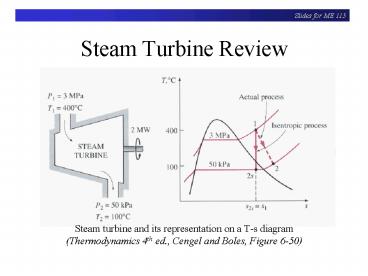Steam Turbine Review - PowerPoint PPT Presentation
1 / 15
Title:
Steam Turbine Review
Description:
Dynamometer: Measures RPM and torque of steam turbine shaft and applies load. ... can be measured using a dynamometer to apply a torque to resist the turning of a ... – PowerPoint PPT presentation
Number of Views:955
Avg rating:3.0/5.0
Title: Steam Turbine Review
1
Steam Turbine Review
- Steam turbine and its representation on a T-s
diagram - (Thermodynamics 4th ed., Cengel and Boles, Figure
6-50)
2
Basic Equations
3
Engine Basics
- Dynamometer Measures RPM and torque of steam
turbine shaft and applies load. - Torque a force acting through a radius common
units - ft lbf
- Brake (shaft) horsepower derives its name from
the fact that the power output of an engine can
be measured using a dynamometer to apply a torque
to resist the turning of a shaft
4
Engine Basics
- Efficiency changes with bhp.
- The maximum efficiency will occur at different
bhps for different RPMs.
5
Temperature and Pressure Measurements
- Temperature
- Thermocouples voltage changes with temperature
- Thermistors and RTDs resistance change with
temperature - Thermometers
- Pressure
- Manometers
- Transducers
6
Temperature Sensors
Industrial thermocouples
Various thermocouple bead styles
Thermocouple probes
Thermometers
Thermistors
7
Thermocouple Basics
- Seebeck effect
- If two wires of dissimilar metals are joined at
both ends and one end is heated, current will
flow. - If the circuit is broken, there will be an open
circuit voltage across the wires. - Voltage is a function of temperature and metal
types. - For small DTs, the relationship with temperature
is linear - For larger DTs, non-linearities may occur.
8
Thermocouple Basics
- If you attach the thermocouple directly to a
voltmeter, you will have problems. - You have just created another junction! Your
displayed voltage will be proportional to the
difference between J1 and J2 (and hence T1 and
T2). Note that this is Type T thermocouple.
www.omega.com
9
External Reference Junction
- A solution is to put J2 in an ice-bath then you
know T2, and your output voltage will be
proportional to T1-T2. - Handheld thermocouple readers and computer data
acquisition systems use something called an
isothermal block instead to perform this task.
10
Comparison of Pressure Instruments
Characteristics Manometer Transducer Dial gauge
Overall Inherently accurate Automation friendly Poor precision
Electronic output No Yes No
Temperature range Approx. -50C to 50C Approx. -200C to 400C Approx. -50C to 50C
Frequency response lt 10 Hz lt 1 MHz lt 10 Hz
Cost 100-2000 50-10,000 10-3000
11
Manometer Basics
- Pressure varies with depth for constant density
fluid
12
Manometers/MicromanometersExamples
(b) Micromanometer
(c) Inclined
Source www.dwyer-inst.com
(a) U-tube
13
Pressure Transducer Basics
Diaphram strain
- Strain on a diaphram is linearly proportional to
pressure difference for the following conditions - A strain gage changes in resistance with strain.
- This resistance change can be indicated by the
voltage output of a bridge circuit.
Strain gage
Bridge circuit
14
Pressure Transducer Examples
(c) General purpose
- Low pressure
- (Validyne DP103)
(d) Miniature
Source www.omega.com
(b) High performance
15
Dial Gauges
- A deformable pressure sensing element is attached
to a pointer which rotates against a graduated
dial--like these childrens party blowouts - Sources of error include human error, hysteresis
Examples from www.omega.com































